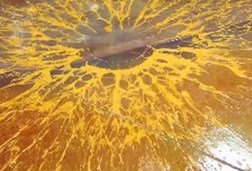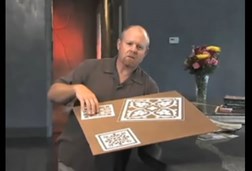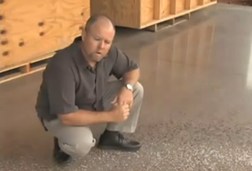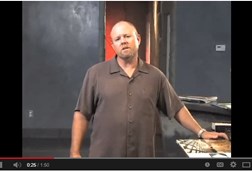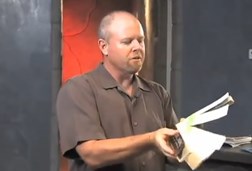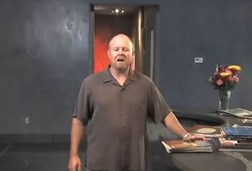- Design Idea Videos
- Floor Type Videos
- Common Question Videos
- Why Concrete Floors?
- Replacing Existing Floors
- Choosing a Floor Contractor
- Floor Maintenance Videos
- More Concrete Videos
- Floor Videos
- Countertop Videos
- Outdoor Living Videos
- Furniture Videos
- Demonstration Videos
- Concrete Tool Videos
- Concrete Stain Videos
- Sealer Videos
- Concrete Stencil Videos
- Concrete Stamps Videos
- Surface Preparation Videos
- Concrete Forms Videos
Floor Design Ideas
"Floor Me" Video Series with Bob HarrisDeciding on whether or not to include concrete floors in your design plans can spur a lot of questions. Get expert advice from Bob Harris on where to get flooring ideas, how to select colors for your floor to match your decor, and how to incorporate stencils and patterns for personalization.
Selecting Colors for Concrete Flooring
Time: 01:21
The great thing about colored concrete is that the options are unlimited and the color is permanent and won't wear away. But that also means you need to choose your colors carefully, keeping in mind the resale value of your home. Bob Harris offers several tips for selecting colors wisely and making sure you choose something you-and someone who might buy your home down the road-can live with.
For more ideas, read Coloring Concrete.
Ideas for Concrete Flooring in Retail Shops
Time: 01:47
Harris explains how the creative use of color in concrete floors in retail environments can help to direct the eye and improve traffic flow. Not only can color be used to define areas in a retail space, it can also designate pathways that guide people to displays and other points of interest.
Photos used in this video provided by Westcoat and Colormaker Floors.
Concrete Floors that Match Your Décor
Time: 01:37
With the use of stains, dyes, integral colors and tints, few flooring materials offer you as many color options as concrete or a concrete overlay, says Harris. Your choices can range from a simple monochromatic floor for a subtle, natural look to an elaborate multicolored design, such as a stenciled border or medallion. Often contractors can custom color the floor to complement your décor, whether you want to match a wall treatment, fabric pattern or artwork.
Stencils for Concrete Floor Overlay
Time: 01:26
Harris explains how you can use paper stencils with thin spray- or trowel-applied overlays to replicate other flooring materials such as tile, slate or stone. Stencils allow you to achieve interesting embossed effects and various degrees of pattern relief. They also are a good way to create borders and define a floor's perimeter.
For more information, read:
Stenciling Interior Concrete Floors
Decorative Concrete Overlays
Stenciling Concrete Floors for Personalization
Time: 02:07
Harris tells you how to take your concrete floor designs over the top by using stencils. Stencils can be used with a variety of techniques to give concrete floors pattern, texture and color. They also allow you to personalize floors with custom patterns, original artwork and corporate logos. Typically made from paper, plastic or even thin plywood, stencils come in a wide array of stock patterns (such as brick, stone or tile designs), or they can be custom cut using a computer-guided plotter to match your own patterns or graphics.
For more ideas, see Logos and Graphics in Concrete.
Stencils and images provided by Modello Designs & Image-N-Concrete Designs.
Concrete Stencils - Ideas & Techniques
Time: 01:45
Intriguing decorative effects are possible by using stencils with sandblasting and gelled-acid etching. Both methods allow you to produce intricate patterns without the need for labor-intensive sawcutting or engraving, says Harris. Here, he describes how each technique is performed.
Look to Your Surroundings for Flooring Ideas
Time: 01:02
With the myriad design options available, it's easy to become intimidated when choosing a color scheme for your concrete floor. As a first step, Harris recommends looking at the room's surroundings, such as the colors of the walls, base molding, furniture and window treatments. If you prefer natural schemes, let Mother Nature be a source for color inspiration.
Images provided by Advanced Concrete Enhancements.
Options for Personalizing Your Concrete Floor
Time: 02:02
When exploring options for personalizing concrete floors, the possibilities are endless. Here, Harris discusses how to complement concrete flooring by pairing it with other flooring materials, such as natural stone, wood inlays, brass strips and even carpet. Another idea is to embed exotic colored aggregates in the concrete floor and then reveal them by polishing.
See more polished concrete design ideas.
Choose a Theme for Your Concrete Floors
Time: 01:50
Bob Harris gives examples of how you can incorporate designs, colors and textures in your concrete floor that pertain to a specific theme. A theme for your floor can be inspired by photographs in design books or your own personal mementos. Concrete is flexible enough to mimic nearly any flooring pattern or color, and it allows you to incorporate personal objects such as old coins and pieces of broken china.
Concrete Floor Design Inspiration
Time: 01:29
Because concrete can so adeptly mimic other flooring materials, Harris suggests looking to other industries for design inspiration. Consider visitinga flooring store and look at pattern samples for tile or go through books and brochures from other industries, such as hardwood flooring catalogs. Show your concrete contractor color swatches of what you want to achieve, so he can pick the right coloring medium for the job.
Intricately Designed Concrete Floor Patterns
Time: 03:08
Harris explains how he reproduces intricate graphic designs on concrete floors by using an overhead projector as an alternative to stencils. He starts by photocopying a design-either original art or an image from a book-onto transparency paper. He then places the paper on the projector bed and shines the design onto the floor from overhead. Then he simply traces the pattern onto the floor and sawcuts the design.
To learn more about this method, view Harris's video on overhead projectors.
Selecting Patterns for Your Concrete Floor
Time: 01:46
Where do concrete floor designs come from? Just look around you, says Harris, because many good design ideas are waiting to be discovered. Some suggestions:
- Page through books of wallpaper or quilt patterns, or look at the patterns on oriental carpets and other area rugs.
- Look at the floors in interior design magazines or in other people's homes, noting patterns or color schemes you like.
- Browse through regional design magazines to gain insight into regional design preferences.
- Visit the websites or showrooms of decorative concrete contractors to see examples of their work.
